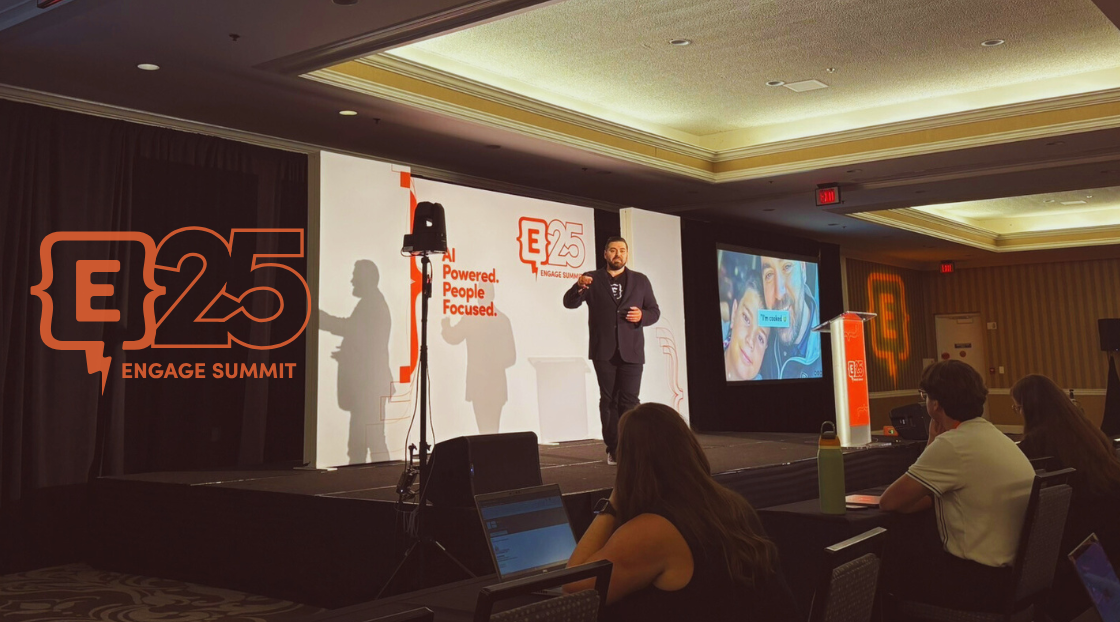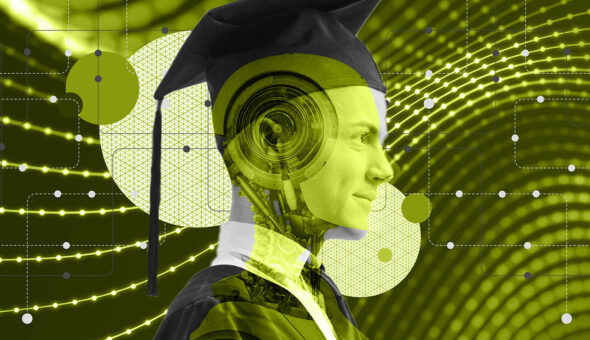The Engage Summit isn’t your typical higher ed conference — and that’s the point. The annual event has evolved over the years from a casual Meetup into a major gathering of early adopters and forward-thinkers that is increasingly focused on AI education and adoption.
For an industry traditionally slow to embrace change and innovation like higher ed, that makes Engage feel radically different from other higher ed conferences while simultaneously highlighting the need for industry professionals to get started anywhere they can — and sooner, not later.
This year’s conference underscored the widespread, rapid adoption of AI and brought together practitioners ready to grapple with the promises and pitfalls of AI in higher ed.
Below are the big themes and takeaways we heard for higher ed leaders, marketers, and technologists — especially those thinking hard about what real AI adoption will mean on their campuses.
1. From Tool to Teammate: The Next AI Leap
Generative AI is evolving rapidly from a tool we prompt to a teammate we manage. The conference highlighted that adoption is already happening at record speed. One session shared a jaw-dropping chart showing generative AI’s adoption curve as the fastest in technology history.
This isn’t about “if,” but “how soon.” As one speaker put it: “This time next year, it’s going to be an everyday tool for everybody.”
But the next frontier isn’t just asking AI to write copy or analyze data. It’s the rise of agents — AI systems that take on autonomous, decision-making tasks. That means organizational change: staff will increasingly manage these AI teammates, training them, overseeing their outputs, and adapting processes accordingly.
For higher ed, that’s a shift from seeing AI as a cost-savings or productivity hack to planning for a whole new staffing and management model.
2. Change Management is Critical—And Urgent
While the technology is racing ahead, the real work lies in human systems.
Several sessions at Engage zeroed in on change management: bringing faculty and staff along, building awareness, and moving from initial curiosity to structured, sustainable use.
AI’s adoption curve is so steep that many institutions haven’t even begun serious change management. And in higher ed—where implementations can be slow and culturally complex—that’s a serious risk.
It means:
- Reducing fear and jargon: Explaining why AI matters, not just what it does.
- Investing in training: Recognizing that AI systems aren’t “set and forget” but need ongoing stewardship.
- Breaking silos: Because AI runs on data, departmental walls make implementation exponentially harder.
That last point is especially in poignant in higher ed, where marcomm, admissions and advancement often operate independently and breaking down those silos is notoriously difficult. AI has the power to do exactly that, with ease.
As one speaker put it: “Silos dissolve when AI becomes the universal translator.” But getting there means proactively sharing data and collaborating across functions.
3. Human-in-the-Loop: Preserving Empath, Creativity and Safety
AI promises staggering efficiency. But speakers at Engage were also clear: AI’s power also demands human oversight and values.
Questions about safety, ethics, and alignment surfaced repeatedly. A memorable moment came when a panelist estimated a 20% chance that advanced AI could pose an existential threat to humanity.
The conversation generally skirted such thought exercises, focusing instead on essential human inputs — the ‘human-in-the-loop’ — that provide empathy, creativity, community-building, and ethics that can’t and shouldn’t be automated. That applies across the breadth of AI adoption, and higher ed has to define how it brings these human elements into its own AI-enabled processes.
4. Meeting Students Where They Are
AI is already in students’ lives. One presenter stated that 90% are using it in some form and noted that implementing AI tools in marketing or student support isn’t “selling” them on new tech — it’s meeting them on familiar ground.
Concrete case studies made this real:
- Georgia State demonstrated how they used a chatbot on their website to reduce summer melt by 22%.
- Another university discovered, via chatbot data, a major content gap on its site — a question students kept asking but which no page answered. Since the chatbot was trained on the website content, it couldn’t help the students. Once this gap was discovered, the university could create that content — and the chatbot could reference it.
5. Rethinking Organizational Structures
Speaking of change management, a fascinating thread that came up in multiple sessions explored who “owns” AI projects on campus.
One takeaway? This can’t just sit in IT. Instead, the AI champion needs to understand the desired outcomes — and how to manage AI like a human employee. That suggests a role for marketers, enrollment managers, and other functional leaders. But it also demands that institutional leadership make AI adoption a clear, top-down strategic priority, not just a passion project for one department.
6. The ROI is Real, But Not Automatic
For skeptics, a few statistics shared at Engage stand out:
- Mature AI adopters report 93x greater ROI than minimal adopters, according to one presenter.
- Adoption of AI agents yields, on average, $75,000 in annual savings, according to another presenter.
- 93% of software features in higher ed CRMs go unused. That problematic stat, cited by another presenter, can potentially be greatly reduced with AI, helping institutions maximize existing investments.
But these gains don’t come free. They require planning, integration, and sustained change management.
7. The Big Picture: Higher Ed’s Purpose in an AI Age
Finally, Engage Summit wrestled with the existential question: What is higher ed for in an age when knowledge is commodified by AI?
One speaker put it this way: if institutions today sell knowledge, credentials, and community, the first will be freely available through AI. That leaves credentials and — critically — community.
That means doubling down on what humans do best:
- Mentorship
- Empathy
- Creativity
- Lifelong learning in community
Higher ed has always been more than just information transfer. AI’s rise only makes that truer.
The Last Takeaway from the 2025 Engage Summit
If Engage Summit had a unifying message, it was this: AI isn’t the future — it’s the present. Adoption is already happening. The institutions that will thrive going forward won’t just buy the tools, they’ll plan for the human and organizational transformation that real AI integration requires.
Because ultimately, as one speaker put it, “AI scales empathy—but humans bring it.”







